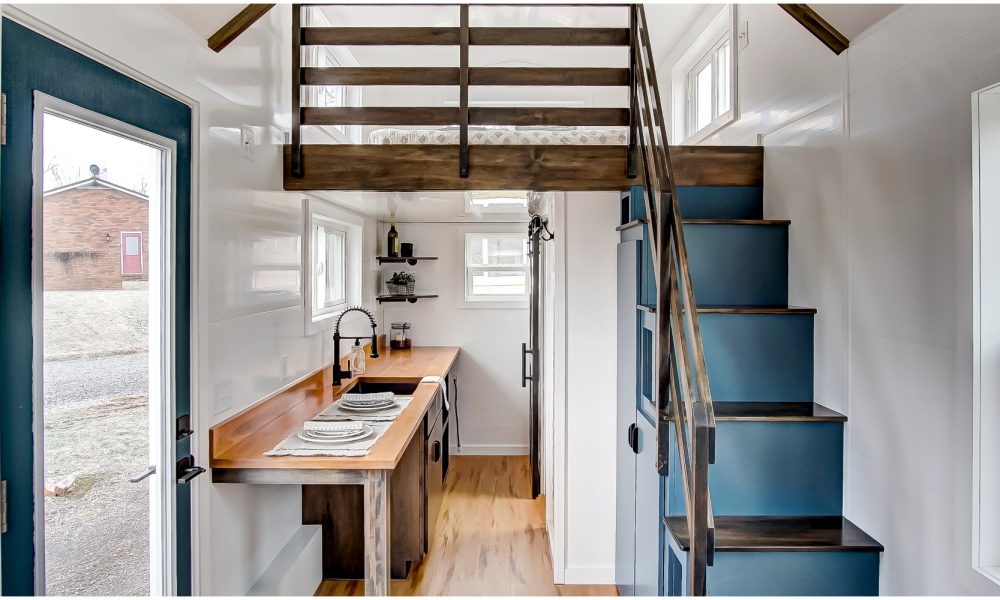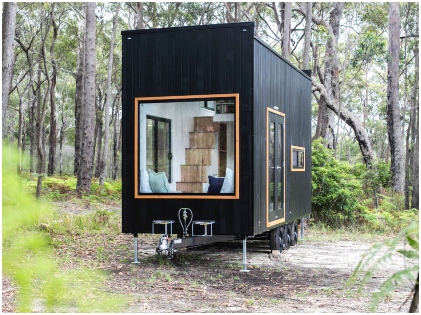
How Opting for a Tiny House Can Help You Save Money

The American Dream has primarily been about hankering after anything bigger and better. If you take a cursory look at the statistics from the last year, you will find a normal American home has gone up from 2400 square feet to almost 2600 square feet. This change took place especially when the housing industry experienced a huge boom. However, although average American nests are increasing in size, experts have noticed a small yet significant trend that’s indicating a movement in the opposite direction. A tiny American home typically covers an area of not more than 500 square feet. How is that beneficial for your pocket? Find it out here.
No More Debt Headaches
 If you look at the statistics you can easily make out that around 60 to 65% of tiny house owners don’t possess a credit card debt, and that’s, indeed, one of the most interesting aspects about the entire thing. In addition to that, 68% of these people don’t need to worry about a mortgage payment as well. Tiny homes that are self-built and constructed on an average budget of something close to $23,000 are cheaper. They look more fabulous than traditional dwellings that are supposed to be built on an identical budget. Since these tiny ones are much smaller in area, you wouldn’t be compelled to stuff it with clutter which otherwise, eventually pushes you into debt. When you are a tiny house dweller, you can choose a lifestyle that leads to lower expenditures and consequently, lower debt.
If you look at the statistics you can easily make out that around 60 to 65% of tiny house owners don’t possess a credit card debt, and that’s, indeed, one of the most interesting aspects about the entire thing. In addition to that, 68% of these people don’t need to worry about a mortgage payment as well. Tiny homes that are self-built and constructed on an average budget of something close to $23,000 are cheaper. They look more fabulous than traditional dwellings that are supposed to be built on an identical budget. Since these tiny ones are much smaller in area, you wouldn’t be compelled to stuff it with clutter which otherwise, eventually pushes you into debt. When you are a tiny house dweller, you can choose a lifestyle that leads to lower expenditures and consequently, lower debt.
Lesser Overhead Expenses
 If you live in a space that covers not more than 500 square feet, you have a lesser amount of area to cool or heat. This implies that the amount you need to expand on your utility bills revolves around more or less $20. Additionally, there is an impressive reduction in your budget as property taxes and other expenses regarding home repair and purchase of large appliances as well as other equipment automatically come down. With less storage space, you will also be discouraged from piling on excess food and consumer items, as discussed before. As a result, your grocery bill comes down and your overhead expenses decrease. Did we mention that you can reduce your carbon footprints by dwelling in a tiny house?
If you live in a space that covers not more than 500 square feet, you have a lesser amount of area to cool or heat. This implies that the amount you need to expand on your utility bills revolves around more or less $20. Additionally, there is an impressive reduction in your budget as property taxes and other expenses regarding home repair and purchase of large appliances as well as other equipment automatically come down. With less storage space, you will also be discouraged from piling on excess food and consumer items, as discussed before. As a result, your grocery bill comes down and your overhead expenses decrease. Did we mention that you can reduce your carbon footprints by dwelling in a tiny house?
Ample Opportunity To Diversify Your Spending
 Although restricted space in tiny houses don’t allow you to splurge on consumable goods and thus help you to save quite a handsome amount of money, you also get an opportunity to simultaneously spend on stuff that you always had an eye for. The freedom of spending whenever you wish to can give you the ultimate satisfaction. This also becomes handy in times when you are in your retirement period and have to afford ever-increasing healthcare expenses. Also, you can have a greater sum in your kitty if you want to make investments into your IRA. The youth who have an affinity to travel and explore new places will have a greater financial backup without having to worry about financial hassles like bankruptcy or debt.
Although restricted space in tiny houses don’t allow you to splurge on consumable goods and thus help you to save quite a handsome amount of money, you also get an opportunity to simultaneously spend on stuff that you always had an eye for. The freedom of spending whenever you wish to can give you the ultimate satisfaction. This also becomes handy in times when you are in your retirement period and have to afford ever-increasing healthcare expenses. Also, you can have a greater sum in your kitty if you want to make investments into your IRA. The youth who have an affinity to travel and explore new places will have a greater financial backup without having to worry about financial hassles like bankruptcy or debt.
Effects On The Economy
 After Hurricane Katrina wreaked havoc, tiny homes proved to be a brilliant option for relief organizations as these dwellings proved to be more long-lasting than trailers. If the last ten years are brought into consideration, a number of non-profit organizations have utilized tiny dwellings as a trustworthy housing option to curb homelessness. Although plenty of homeowners are really worried about the effect that tiny houses can have on the values of their properties, these dwellings might have a positive impact on the economy as well as the environment in the coming days as they might lead to massive land development and accentuated property values.
After Hurricane Katrina wreaked havoc, tiny homes proved to be a brilliant option for relief organizations as these dwellings proved to be more long-lasting than trailers. If the last ten years are brought into consideration, a number of non-profit organizations have utilized tiny dwellings as a trustworthy housing option to curb homelessness. Although plenty of homeowners are really worried about the effect that tiny houses can have on the values of their properties, these dwellings might have a positive impact on the economy as well as the environment in the coming days as they might lead to massive land development and accentuated property values.
There are several advantages of living in a tiny house. Irrespective of what you prefer personally or your space requirements, the other benefits that tiny dwellings come along can’t be denied. It doesn’t come as a surprise that more and more people are not inclined to The American Dream anymore. Their moving away from the concept has redefined the idea of affordable housing in the American context. Many Americans have already chosen to switch to smaller and greener homes. Are you next in line?
More in Business & Investments
-
`
WWE SmackDown to Make a Comeback on USA Network in 2024
In a surprising twist, WWE’s Friday night staple, “SmackDown,” is bidding farewell to Fox and heading back to its old stomping...
November 24, 2023 -
`
Why Women Face Higher Out-of-Pocket Health Expenses
In healthcare, disparities persist, and a recent report from Deloitte underscores a significant financial gap between working women and men in...
November 18, 2023 -
`
Elon Musk vs Bill Gates: The Clash of Titans
In the realm of the world’s wealthiest individuals, a simmering rivalry has been captivating public attention. It’s not a clash of...
November 7, 2023 -
`
The Power Of Disconnecting
In our digitally driven age, where smartphones, tablets, and laptops have become extensions of ourselves, disconnecting might seem daunting. However, the...
October 31, 2023 -
`
JCPenney’s Bankruptcy: The End of an Era
JCPenney filed for bankruptcy in a move echoing the struggles of many retailers in the wake of the COVID-19 pandemic. This...
October 26, 2023 -
`
Reasons Why You Need a Financial Plan
Financial planning is not just for the wealthy or those nearing retirement. It’s a crucial tool for anyone seeking financial security...
October 19, 2023 -
`
How Brad Pitt Spends His Millions All Over the World
Brad Pitt, the charismatic Hollywood superstar, has left an indelible mark on the silver screen and made an impact in the...
October 10, 2023 -
`
Gen Z’s Posh Palate: The Unexpected Rise of Caviar Culture
Amid the backdrop of a digital era buzzing with viral dances, e-sports, and niche memes, there emerges a peculiar plot twist:...
October 7, 2023 -
`
Transform Your Retail Business With Social Media Mastery
If you’re a retail marketer posting your social media messages haphazardly, you might be missing out on prime opportunities to turn...
September 26, 2023















You must be logged in to post a comment Login